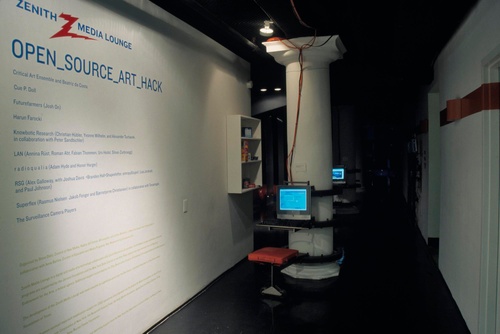Open\\_Source\\_Art\\_Hack
Open\\_Source\\_Art\\_Hack
“Hackers create the possibility of new things entering the world. Not always great things, or even good things, but new things. In art, in science, in philosophy and culture, in any process of knowledge where data can be gathered, where information can be extracted from it, and where in that information new possibilities for the world produced, there are hackers hacking the new out of the old.” —McKenzie Wark, Hacker Manifesto 2.0
In mainstream culture, hacking has many—mostly negative—connotations. Acts of hacking can range from relatively harmless pranks, to those that have economic consequences, to criminal actions. The activity itself elicits both fear and fascination, and its aura of anonymity and inscrutability makes it ripe for media exaggeration. Especially after September 11, 2001, the usual official response to any kind of hacking has been to indiscriminately codify it as “cyber-terrorism,” diverting attention from its significant social implications.
In an age of increased surveillance, rampant commercialization, and privatization of everything from language, to biological entities, to supposedly personal information, hacking—as an extreme art practice—can be a vital countermeasure. Particularly when combined with the ethics of the “open source” movement, hacking represents an important form of institutional critique. Originally devised as a process for the community creation and ownership of software code, open source offers abundant applications for artists—and the public—because of its transparency and communality. Open source allows artists to become providers of functional tools with which users can create new forms of information aesthetics, modes of activism, and content. Within this hybrid domain, they can intervene on- and off-line, operating in public and hacking the private, alternating or combining digital and analogue.
This exhibition includes the work of artists from the United States, Switzerland, Denmark, Australia, and the United Kingdom who approach hacking as a creative electronic strategy for resistance, rather than as a merely destructive act. By using media and technology tactically, transparently, and collaboratively, the artists reveal and subvert the way in which society, institutions, governments, or corporations undermine individual identity, local control, and citizen agency. The work in Open\_Source\_Art\_Hack is new, but not without history, since it shares an important legacy with artists who have always been interested in the politics of art as a mechanism of protest.
LAN’s Tracenoizer works on the principle of disinformation, using automated tools to create a fake homepage based on searching the Internet according to a person’s first and last names. This fake homepage is then propagated through various search engines, so that it becomes impossible for anyone to verify personal data, providing a measure of anonymity. Knowbotic Research’s Minds of Concern::Breaking News consists of a gallery installation, web interface, and news tickers. The project web site contains a Minds of Concern list of groups, movements, and non-governmental associations (NGOs) that have a global presence on the Internet. By clicking a name, visitors trigger a set of network processes that investigate the security conditions of a group’s server. The results are made available on a news ticker that literally “visualizes” the strength or vulnerability of a server and strobe lights and sounds correspondingly vary in intensity in the gallery installation.
International computer collective RSG presents the packet-sniffing Carnivore, which eavesdrops on network traffic through a wiretap device that plugs into a local area network. By making the resulting data stream available on the net, an unlimited number of “clients” can tap into, and visually interpret this data. For the title of the work, RSG appropriated the name Carnivore, which, until recently, was the nickname for DCS1000, a piece of software used by the FBI to perform electronic wiretaps. Australian-born, London-based on-line art group r a d i o q u a l i a transmit a low-power radio broadcast, Free Radio Linux—literally lines of Linux source code—in the museum lobby and through headphones suspended in the bookstore. In Anti-wargame, Future Farmers’ Josh On challenges the ideology behind most computer games (that tend not to reward players with a social conscience) with his own, anti-imperialist version. Cue P. Doll/rtmark jams the mediascape by turning an advertising tool—a mouse barcode reader—into a means of determining the ecological value of particular items by matching them with a database of consumer products and their effects on the environment. Berlin-based artist Harun Farocki’s Eye Machine investigates “intelligent” machines and weapons, while in her lecture Pretty Good Privacy, Rena Tangens addresses issues of privacy, encryption and surveillance.
By their very nature, Open\_Source\_Art\_Hack projects extend beyond the museum itself, technologically and, in some cases physically. The Surveillance Camera Players perform in front of public and hidden surveillance cameras in Soho and mid-town, and Danish collective Superflex work with local communities to create a Superchannel streaming media broadcast that can also be viewed on the museum mezzanine. By using open source, artists extend the life of projects in a way that revises the relationship between artist, audience, and the social sphere (both virtual and real).
Organized by Steve Dietz, Curator of New Media, Walker Art Center, Minneapolis, and Jenny Marketou, artist, New York City, in collaboration with Anne Barlow, Curator of Education and Media Programs.





























